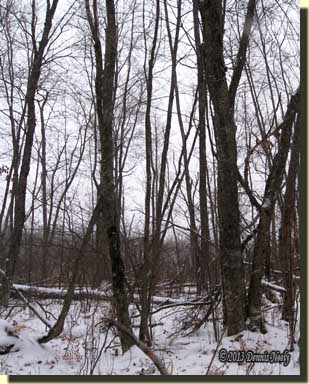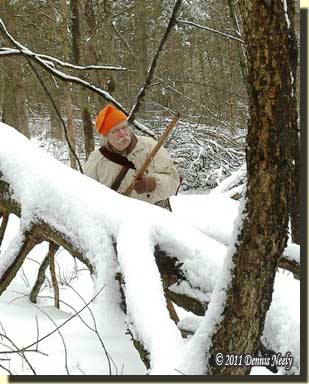Treetops swayed. Gusts whooshed in the barren branches. Winter moccasins, made of buffalo hide and lined with trade blanket pieces, stepped cautious. Red blanket tails, encrusted with snow, flapped against deerskin leggins. Wolf tracks wove in and around the hardwoods, headed to the River Raisin’s bottomlands and protection from the frigid west wind on that bleak Thursday in the Year of our Lord, 1796.
The meager post’s supply of venison ran short; Samuel the Trader expected his hired hunter to remedy that situation. A fox squirrel bounded in the snow, romping from one oak tree to the next. Screaming crows treed to the south; other black demons hollered to the east.

The still-hunt pressed on to the yellow tree, the wound to the split oak now weathered, more gray than sapwood yellow. Moccasins crept down the rise, through the slender white ashes, then across the narrow strip of solid ground to the first earthen mound, dubbed Tamara’s Island. The post hunter’s course followed the west edge, circling deeper into the tangled abyss of snow-covered mucky puddles and wind-tipped maple saplings.
White fluff weighed down the dried sedge grass patch. In the eastern third of that tiny oasis, four yellow birch trees grew in an odd configuration. Two angled in the direction of the River Raisin and the main deer trail that paralleled the river’s course, inside the slash rather than out in the cattails. The third, twisted and gnarly, leaned to the east. The last one, the size of a powder keg, towered straight and tall.
Like gripping hands with bent fingers, tense knuckles and clawing nails, the four root systems intertwined, forming an ankle-high seat above the muck and mire. Years of green moss covered and cushioned the weave. A wool-clad hand dusted away the snow, taking care not to disturb the spongy, unfrozen clumps.
After a careful look-around, the woodsman’s blanket roll settled in place in front of the largest tree, but behind the other three. The post hunter sat cross-legged in the nest. His eyes peered just above the sedge grass, his body hidden from the view of passing whitetails…
Coyotes Morph into Wolves
Coyotes are a problem predator in southern Michigan. Either sightings or notations of tracks in the sand, mud or snow show up in my alter ego’s journal entries. But the mention of a coyote raises an historical issue in an 18th-century, lower Great Lakes narrative: coyotes didn’t exist. If such a reference finds its way into the field notes, it usually gets passed over when the time-traveling adventure makes print.
Wolves traipse through many period documents and there is little doubt they once roamed on the North-Forty, near the headwaters of the River Raisin. The History of Jackson County Michigan contains many references to wolves, penned by the early settlers of the area. One such recollection, written by Reverend Asahel A. King tells of the winter of 1837, the same year Michigan entered the union.
“The wolves used to howl terribly at night. In the winter of 1837 they killed and ate an Indian, near the corner of Tompkins, Eaton Rapids, Springport and Onondaga townships [the northwest intersection of Jackson County with Eaton and Ingham Counties]. He backed up against a tree and fought with his hatchet until he killed seven wolves; then he was overpowered. His hatchet, some of his clothing and part of his body and the wolves were soon found. Many others made very narrow escapes” (History of Jackson County, 199 – 200).
Mrs. M. W. Clapp reinforced King’s statement, not far from the North-Forty, and again, in 1837: “…the wolves and screech-owls would sometimes make night hideous…” (Ibid, 204)

Now and again I address the principle of “measured compromise,” whereby the re-enactor’s mind measures the intrusion of a modern-day circumstance, weighs the significance or danger of the transgression and applies a compromise that nullifies the impact on a given history-based pursuit. The usual intrusion takes the form of a silvery balloon, passing aircraft or crushed soda can.
Coyote evidence presents a different problem, that of a modern forest tenant not fitting into a faithful quest to experience the texture of daily life in the Old Northwest Territory, two-plus centuries removed. In the case of the coyote, the easiest solution to retelling a wilderness tale is to apply a little “writer’s license” and transform the offending creature into one that existed in the 1790s.
And if that substitution is not acceptable, then my newest fictitious character, that of a primitive hunter and gatherer one generation beyond the Neanderthals, is in deep hooey, too. In his case, the etchings on his stone tablets depict modern woodchucks. However, when he shares his harrowing hunt with his family around an orange-flamed, crackling fire, he transforms those offending creatures into woolly mammoths, the bones of which are occasionally dug up not all that far from the North-Forty…
Give traditional black powder hunting a try, be safe and may God bless you.



One Response to Transforming an Offending Transgression